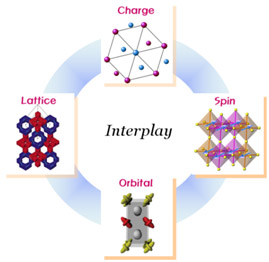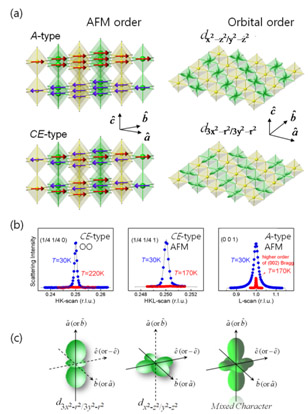
A fundamental feature of emergent materials involves the interplay among charge, orbital, spin, and lattice degrees of freedom that induces a staggering variety of exotic phenomena, such as colossal magnetoresistance, metal-insulator transition and magnetoelasticity. Moreover, each degree of freedom is tunable via doping, resulting in changes of valence state and local structure, which easily causes a variation of the ordered phase. In this fashion, the La2-2xSr1-2xMn2O7 bilayer manganite has attracted much attention in the past two decades due to a variety of emerging phenomena involving intimate couplings of the degrees of freedom. These couplings result in a complex magnetic phase diagram of ferromagnetic (FM) as well as different antiferromagnetic (AFM) phases in variations of the doping level x and temperature. For the half-doped case (x=0.5), the A-type AFM order was observed experimentally, although the CE-type order is predicted in the Goodenough model1 based on the orbital states originally proposed for doped manganites.
Recently, a careful doping control study, however, reported that the system has an exotic phase diagram very near the half doping with extremely narrow AFM phase boundaries at x ≈ 0.5 ± 0.005—the CE-type within the boundaries but theA-type outside.2 The study confirmed the predicted CE-type AFM order for the true half-doped (x = 0.5) case, but such a narrow phase boundary, which indicates close competition of the two phases, is puzzling since the CE-type order is expected to be rather stable in the model, as also observed in other half-doped manganites.
Furthermore this system consists of MnO2 magnetic bilayers between nonmagnetic (La,Sr)O layers. In the x ≈ 0.5 case, Mn3+ and Mn4+ ions are ordered alternately in the MnO2 bilayers, and the orbital of the additional egelectron at the Mn3+ site becomes ordered in the checkerboard (zigzag) pattern, i.e., the orbital order (OO), below Too = 210 K. Based on the orbital order pattern, the magnetic spins can be ordered in either the CE-type or A-type pattern (see Figure 2a). The magnetic exchange interactions strongly depend on the orbital states, and the CE-type AFM order is expected to be favored in the 3x2-r2/3y2-r2-type orbital order as discussed in the model, while the A-type one to be in thex2-z2/y2-z2-type order, which possibly activates the in-plane FM double exchange. Therefore, to understand the exotic phase diagram near x = 0.5 certainly requires information not only on the detailed ordering behaviors of the competing CE-type and A-type AFM orders but also on the related orbital characters.

For understanding the many unknown issues on this compound, SSRL scientists Jun-Sik Lee and Chi-Chang Kao, along with their colleagues at Brookhaven National Laboratory, University of Illinois, University of Rutgers, and Pohang University of Science and Technology took a closer look at one such material with a particular half doped composition, LaSr2Mn2O7. The researchers chose a study of the resonant soft x-ray scattering (RSXS) technique at the Mn L2,3edge, because such technique provides both the ordering and the electronic (spin and orbital) information. These measurements were carried out at Brookhaven National Laboratory’s National Synchrotron Light Source; as such experiments are important for future materials science research, SSRL plans to develop the instrumentation required for this type of study as well.
In a study recently published in Physical Review Letters, the researchers report details of orbital and magnetic ordering behaviors of the half-doped bilayer manganite La2-2xSr1-2xMn2O7 (x ≈ 0.5), in which the competing CE-type and A-type AFM orders coexist. As shown in Figure 2b, large resonant enhancements at the reflection peaks of the CE-type (1/4 1/4 0) orbital order as well as the CE-type (1/4 1/4 1) and A-type (001) AFM orders. The orbital order reflection was found to be a composite of one involving the CE-type AFM order and the other involving the A-type one. The temperature dependence studies clearly show coupling behaviors of the coexisting CE- and A-type AFM orders, meaning that both AFM phases are not simply segregated. Examining the energy profiles of the orbital order peak and the spectroscopic study, the researchers found that the egstate (i.e., 3d Mn orbital) involving the CE-type AFM order has nearly the same orbital character as that involving the A-type one. The orbital character is identified as a 2:1 mixture of 3x2-r2/3y2-r2 and x2-z2/y2-z2 characters—orbital instability (see Figure 2c).
These results strongly suggest the fragile magnetic ground state of the half-doped LaSr2Mn2O7, in which the close competition of the CE-type and A-type AFM ground states exists, yields the extremely narrow phase boundaries (i.e., through a tiny deviation in the doping level). Meanwhile, such an orbital instability offers a rich opportunity for detailed experimental and theoretical investigations. Moreover, this finding is especially relevant as recent experiments have found exotic phenomena in the heterostructures that consist of complex oxide materials, and demonstrates the rich variety of interfacial spin couplings that can occur in complex oxide thin films that may be utilized in engineering spintronic-devices for our future.
1. J. B. Goodenough, Phys. Rev. 100, 564 (1955).
2. Q. Li et al., Phys. Rev. Lett. 98, 167201 (2007).
J.-S. Lee, C.-C. Kao, C. S. Nelson, H. Jang, K.-T. Ko, S. B. Kim, Y. J. Choi, S.-W. Cheong, S. Smadici, P. Abbamonte, and J.-H. Park “Fragile Magnetic Ground State in Half-Doped LaSr2Mn2O7” Physical Review Letters 107, 037206 (2011).




